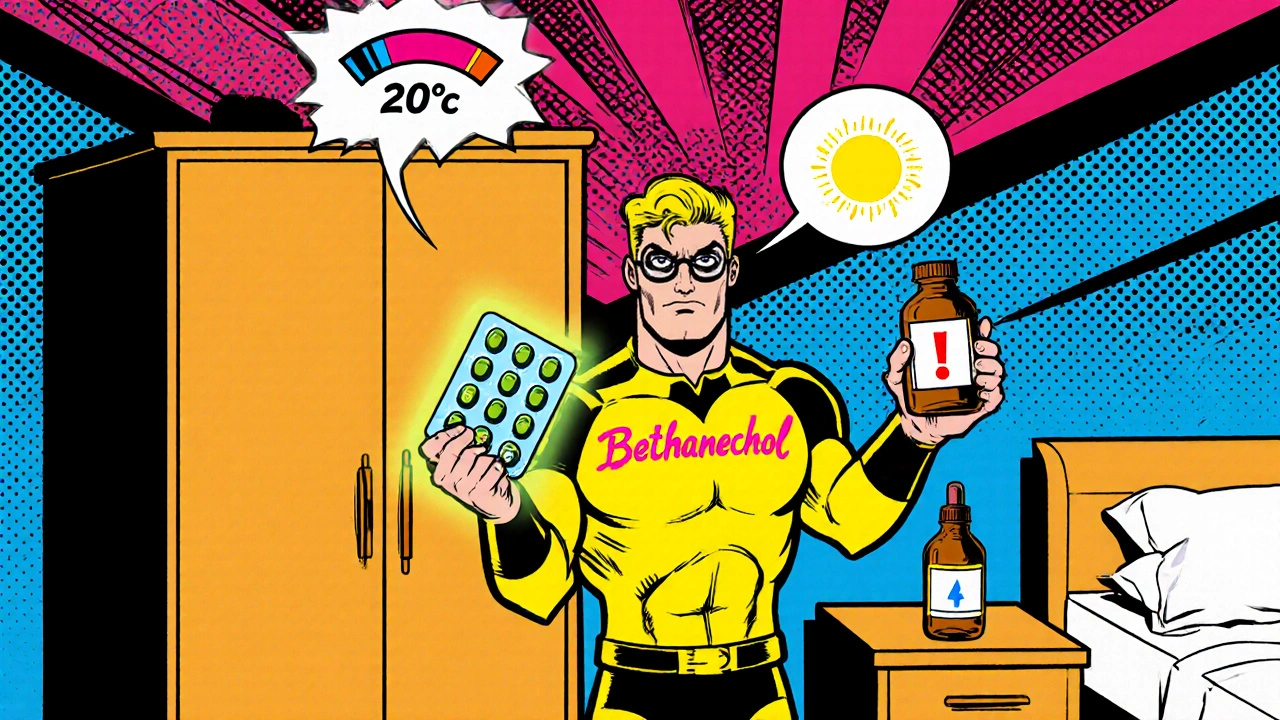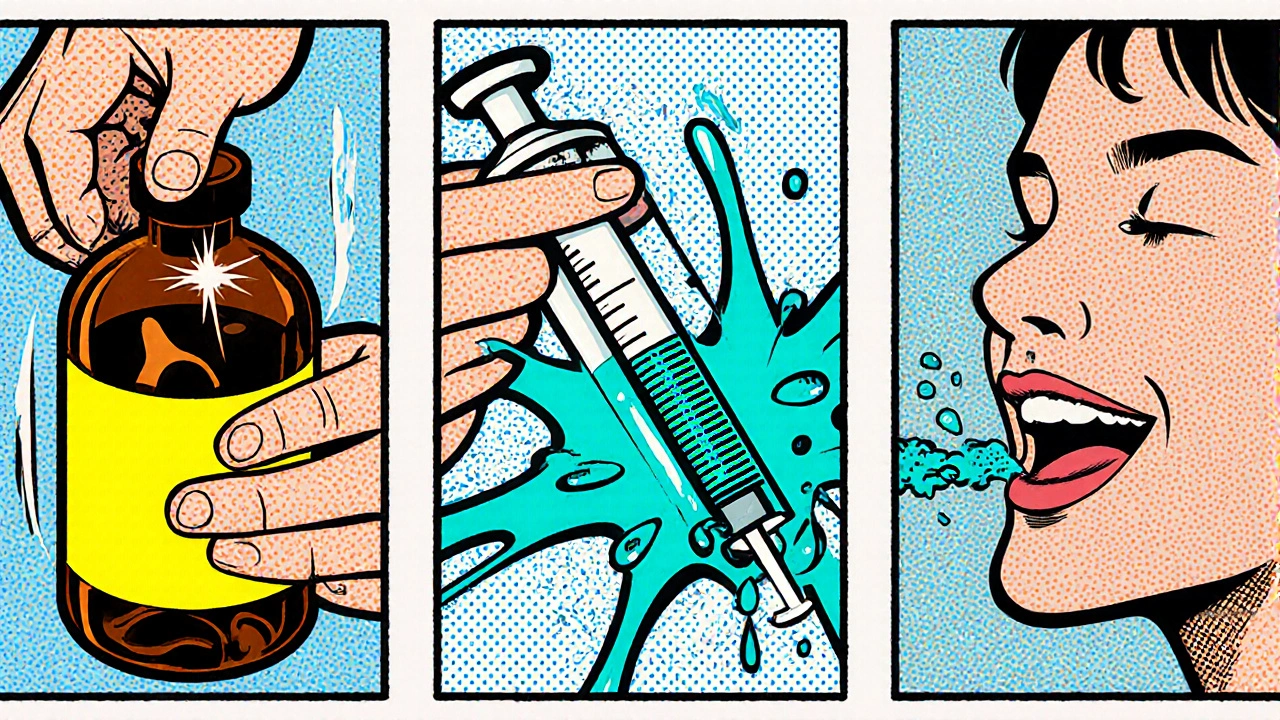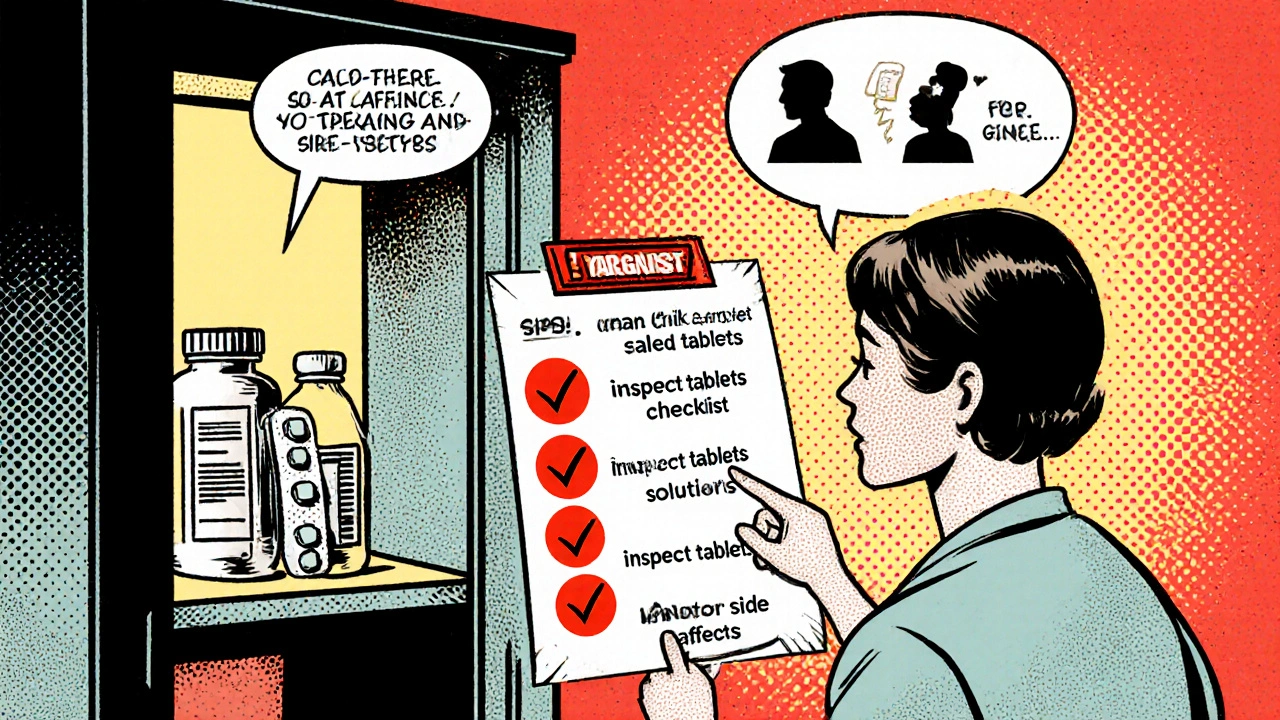Safe Home Storage and Administration Guide for Bethanechol
 Oct, 15 2025
Oct, 15 2025
Bethanechol Oral Solution Dose Calculator
How to Use This Calculator
Bethanechol oral solution is 5mg per 5mL. Enter your prescribed dose in milligrams (mg) to calculate the exact volume you need to measure.
Your Dose
Ever wondered why your doctor gave you Bethanechol and how you can keep it safe at home? You’re not alone. This guide breaks down everything you need to know about storing and giving this medication correctly, so you avoid wasted doses, mishaps, and unnecessary trips to the pharmacy.
Key Takeaways
- Bethanechol is a cholinergic agonist used mainly for urinary retention and postpartum bowel problems.
- Store the drug in a cool, dry place-usually between 15‑30°C (59‑86°F) and protect it from light.
- Most patients receive tablets; a liquid oral solution is also available for those who can’t swallow pills.
- Follow a strict dosing schedule and measure liquid doses with a calibrated syringe, not a kitchen spoon.
- Watch for side effects like sweating, abdominal cramps, or low blood pressure, and know when to call a pharmacist or doctor.
What is Bethanechol and When Is It Used?
Bethanechol is a synthetic cholinergic agonist that stimulates smooth muscle in the bladder and gastrointestinal tract. It’s prescribed primarily for urinary retention after surgery and for postoperative ileus when the intestines need a gentle push to start moving again.
The drug works by mimicking the action of acetylcholine, a natural neurotransmitter, without affecting the heart or lungs. Because it targets specific muscles, it’s generally safe when taken exactly as directed.
Forms You’ll Find at Home
Bethanechol comes in two common formats:
- Tablet - the most widely prescribed form, usually 10mg per tablet.
- Oral solution - a liquid concentration of 5mg per 5mL, helpful for children or adults with swallowing difficulties.
Both forms require careful handling, but the solution demands an extra step: accurate measurement with a dose‑measuring device.

How to Store Bethanechol Correctly
Improper storage can degrade potency, leading to ineffective treatment. Follow these simple rules:
- Keep the medication in its original container with the child‑proof seal intact.
- Store in a location that stays between 15‑30°C (59‑86°F). A kitchen cupboard away from the stove works, but a bedroom nightstand is often more temperature‑stable.
- Avoid direct sunlight and extreme humidity. If you live in a humid climate, consider a dehumidifier in the storage area.
- Do not refrigerate unless the label explicitly says so. For the oral solution, refrigeration isn’t needed and can cause precipitation.
- Check the expiration date regularly. Discard any tablets that have changed color, texture, or smell.
Below is a quick comparison of ideal storage conditions for each form:
| Form | Temperature Range | Light Exposure | Container | Shelf‑Life After Opening |
|---|---|---|---|---|
| Tablet | 15‑30°C (59‑86°F) | Low‑light or opaque container | Original blister‑pack or bottle | 24 months (check label) |
| Oral solution | 15‑30°C (59‑86°F) | Store away from direct sunlight | Amber glass bottle with dropper | 12 months after first use |
Administering Bethanechol Safely
Whether you’re taking tablets or the liquid, consistency is key. Here’s a step‑by‑step routine that most patients find easy to follow.
Tablet Administration
- Read the prescription label carefully. Note the exact dosage (e.g., 10mg) and timing (usually every 6‑8hours).
- Wash your hands before handling the medication.
- Take the tablet with a full glass of water. Do not crush or chew unless your pharmacist says it’s safe.
- If you miss a dose, take it as soon as you remember-provided it’s more than 4hours before the next scheduled dose. Otherwise, skip it and resume the regular schedule.
Oral Solution Administration
- Shake the bottle gently for 5seconds to ensure even distribution.
- Use a calibrated oral syringe (usually supplied with the medication). Do not use kitchen spoons; they are inaccurate.
- Draw the prescribed volume (e.g., 5mL) and place it on the tongue.
- Swallow without chewing. If the taste is unpleasant, follow it with a sip of water.
- Replace the cap tightly after each use to prevent oxidation.
Always keep a log of the times you take each dose. A simple notebook or a phone reminder works well and helps you avoid double‑dosing.
Safety Checklist and What to Watch For
Even a well‑behaved medication can cause problems if something goes wrong. Keep this checklist handy:
- Confirm the medication name and strength before each dose.
- Inspect tablets for cracks or discoloration; discard compromised ones.
- For the solution, ensure the bottle is not cloudy or sedimented.
- Monitor for side effects: excessive sweating, abdominal cramps, nausea, low blood pressure, or rapid heart rate.
- If you experience any of these, pause the medication and call your pharmacist or doctor right away.
- Keep the medication out of reach of children and pets.
- Store the emergency contact numbers of your prescriber and local pharmacy in a visible spot.
When in doubt, a quick phone call to a qualified pharmacist can prevent serious issues.

Frequently Asked Questions
Frequently Asked Questions
Can I store Bethanechol in the refrigerator?
No. The label advises storing at room temperature (15‑30°C). Refrigeration can cause the tablet coating to break down and the liquid solution to become cloudy, reducing effectiveness.
What should I do if I accidentally take a double dose?
Call your pharmacist or emergency services immediately. Double dosing can lead to severe bradycardia, hypotension, and excessive sweating. Do not wait for symptoms to appear.
Is it safe to use kitchen spoons to measure the oral solution?
No. Kitchen spoons vary in volume and can cause under‑ or overdosing. Always use the calibrated syringe that comes with the bottle.
How long does an opened bottle of Bethanechol solution stay effective?
Most manufacturers state a 12‑month shelf‑life after first use, provided the cap remains sealed tightly and the bottle is stored as directed.
Can I take Bethanechol with other medications?
Bethanechol can interact with anticholinergic drugs (e.g., atropine) and certain beta‑blockers. Always share your full medication list with your prescriber.
Next Steps if Problems Arise
If you notice any unusual symptoms or suspect the medication has been stored incorrectly, follow this quick decision tree:
- Stop taking the drug immediately.
- Check the storage conditions - temperature, container integrity, expiration date.
- Contact your pharmacist with a description of the issue.
- If advised, schedule a brief appointment with your doctor to discuss alternative treatments.
Keeping a small “medication emergency kit” that includes the drug label, a copy of the prescription, and your pharmacist’s phone number can save you minutes in a crisis.
By following the storage guidelines, measuring doses accurately, and staying alert for side effects, you’ll get the full benefit of Bethanechol while minimizing risk. Remember: a well‑organized medicine cabinet is a small investment that pays big dividends for your health.

Tommy Mains
October 15, 2025 AT 20:59Great rundown of storage rules. Keeping Bethanechol in its original bottle and away from heat helps it stay potent. A simple tip is to label the cabinet with the temperature range so everyone knows. Remember to use the syringe that comes with the liquid-it’s the only way to get the right dose. If you keep a small log on your phone, you’ll never miss a dose.
Richa Ajrekar
October 19, 2025 AT 08:19Your guide is okay but there are a few grammatical slips. For example, “keep it safe” should be “keep it safely”. Also, “a quick phone call” could be “making a quick phone call”. The content otherwise covers the basics.
Pramod Hingmang
October 22, 2025 AT 19:39Bright colours of safety shine when you stash the tablets in a cool drawer. The amber bottle of solution looks like a tiny sunrise on your shelf. Shake it gently like a sunrise breeze and sip with a glass of water. Avoid the kitchen spoon-its shape can betray your dose. Keep the lock tight and the light low, and the medicine will sing.
Inma Sims
October 26, 2025 AT 05:59Ah, because everyone loves a manual on how to store a drug they barely pronounce. Your checklist is as exhaustive as a grocery list, yet somehow still manages to be thrilling. Perhaps next time you’ll include a section on how to arrange the spice rack for optimal pharmacology. Nonetheless, the advice is sound-if you can stomach the prose.
Gavin Potenza
October 29, 2025 AT 17:19Is a pill just a pill, or does it carry the weight of our choices? Storing Bethanechol properly is a small act of stewardship over our own bodies. Think of the cabinet as a tiny temple where the medicine rests in peace. Keep it cool, keep it dark, and let the chemistry do its work. In the grand scheme, it’s a modest yet meaningful ritual.
Sandy Gold
November 2, 2025 AT 04:39So essentially the guide says keep the med in a room temp zone, wich is pretty basic huh? I mean, if you’re already reading this you probably already know not to put it in the freezer. Still, the whole “use calibrated syring” part is a nice reminder tho. And yeah, the fancy table formatting looks like a lab report, but it's just a drug guide. Anyway, good job but could be more in depth.
Frank Pennetti
November 5, 2025 AT 15:59The protocol delineated here suffers from an overreliance on layman vernacular, neglecting the pharmacokinetic nuance essential for optimal therapeutic index maintenance. Absence of discussion regarding bioavailability variance between tablet disintegration and liquid solubilization is a glaring omission. Moreover, the advisory lacks a mechanistic exploration of cholinergic agonist‑induced autonomic modulation. In short, the guide is superficial and fails to address critical safety parameters.
Adam Baxter
November 7, 2025 AT 09:39Use the supplied syringe, never a spoon.
Mariah Dietzler
November 9, 2025 AT 03:19I guess the info is ok. Not much else to add.
Nicola Strand
November 12, 2025 AT 14:39While the guide presents a thorough overview, it neglects the broader context of polypharmacy interactions that patients frequently encounter. It seems presumptuous to suggest a one‑size‑fits‑all storage solution without accounting for regional climate variations. Furthermore, the advice on dosage timing sidesteps the complexities of circadian pharmacodynamics. A more critical appraisal would include these considerations.
Shruti Agrawal
November 16, 2025 AT 01:59Thank you for putting together such a clear set of steps; the language is easy to follow. I especially appreciate the reminder to wash hands before handling the medication. Just a tiny note: the phrase “store in a location that stays between 15‑30°C” could be tightened to “store where temperature stays between 15‑30 °C”. Keep up the good work!
Katey Nelson
November 17, 2025 AT 19:39Reading this guide felt like embarking on a mini‑adventure through the mundane world of medication management 😊. First, the emphasis on keeping Bethanechol out of direct sunlight is a classic reminder that even pills have a sweet spot for light exposure. Imagine the bottle perched like a tiny lighthouse on a shelf, guarded against the harsh glare of the kitchen window. If the cabinet temperature swings like a temperamental teen, the drug's potency may wilt, much like a plant left without shade. Thus, placing the medication in a climate‑stable nook, perhaps near the refrigerator but not inside it, creates a Goldilocks zone. The author’s suggestion to use the calibrated syringe is gold, because measuring with a common spoon is akin to guessing the weight of a feather with a hammer. When you shake the oral solution gently, you are honoring the principle of homogeneity, ensuring each milliliter contains the same amount of active compound. A quick tip that could be added is to periodically label the syringe with the date of first use, so you never lose track of the twelve‑month window. The checklist at the end serves as a mental safety net, catching any oversight before it becomes a mishap. Monitoring for side effects such as sweating or low blood pressure is not just a medical directive, it is a reminder to listen to your own body’s whispers. If any of those symptoms appear, pausing the medication and contacting a pharmacist is the prudent course, much like pulling over when a car makes a strange noise. The guide also wisely advises against refrigeration, which could provoke precipitation in the liquid and alter its efficacy. Storing the medicine in its original child‑proof container respects both safety regulations and the manufacturer’s stability data. Adding a small notebook or a phone reminder to log each dose transforms a routine into a disciplined practice, boosting adherence. Overall, this comprehensive approach turns a potentially confusing task into an empowering daily ritual, and that is something to celebrate 🎉.
Joery van Druten
November 21, 2025 AT 06:59One practical addition is to keep a spare calibrated syringe in a separate drawer; this prevents loss of the original device. Also, consider labeling the bottle with the date of opening, which helps track the 12‑month shelf life. The guide’s temperature recommendations align with stability data from the manufacturer. Overall, the information is solid and can serve as a reliable reference.
mathokozo mbuzi
November 24, 2025 AT 18:19I would like to inquire whether the stability of Bethanechol tablets is affected by intermittent exposure to humidity in climates such as ours. Could a simple desiccant packet placed in the storage container extend the product’s lifespan? Additionally, are there any documented cases of potency loss when the medication is stored near electronic devices that emit heat? Your clarification on these points would be appreciated.
Amy Aims
November 28, 2025 AT 05:39Great effort on the guide-feels like a helpful friend in the medicine cabinet! Keep it upbeat and maybe add a quick visual aid for dosage measuring 😊. Looking forward to more such practical health tips!